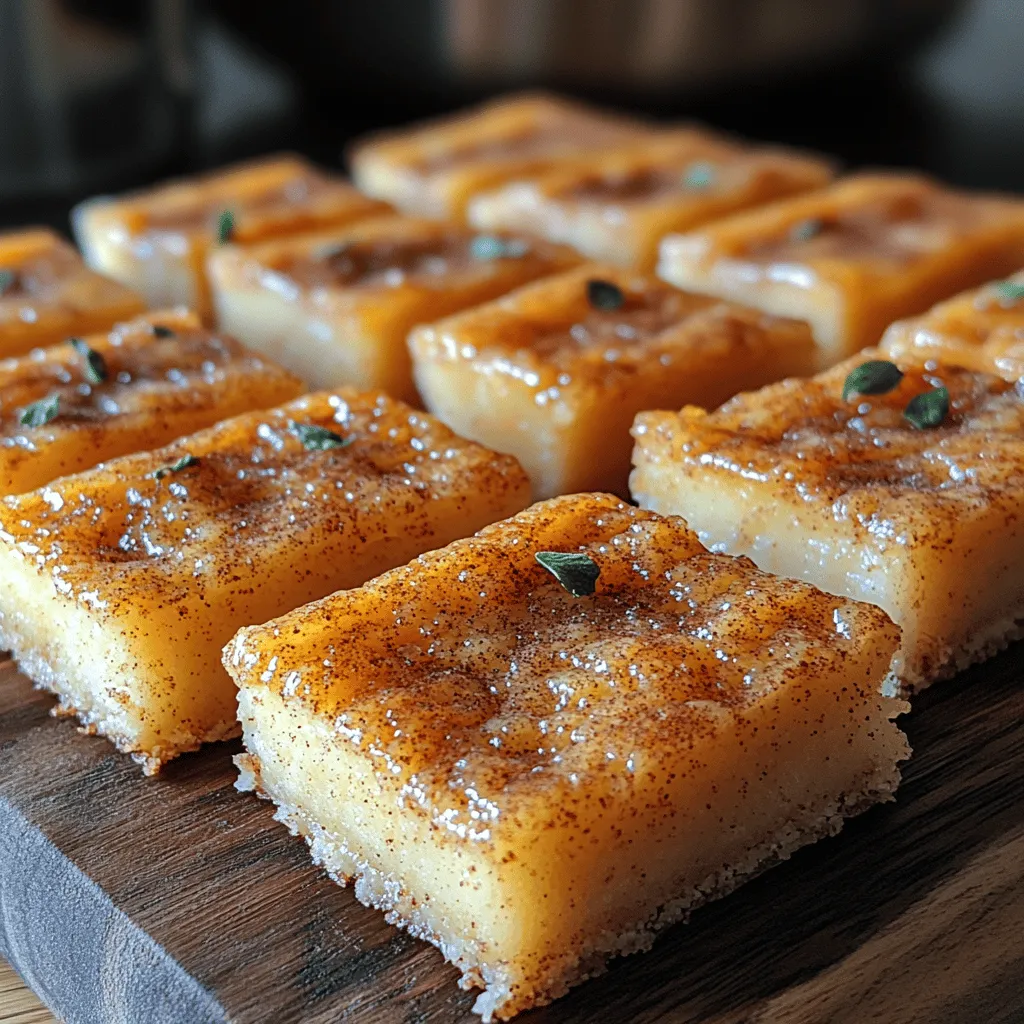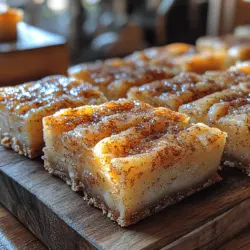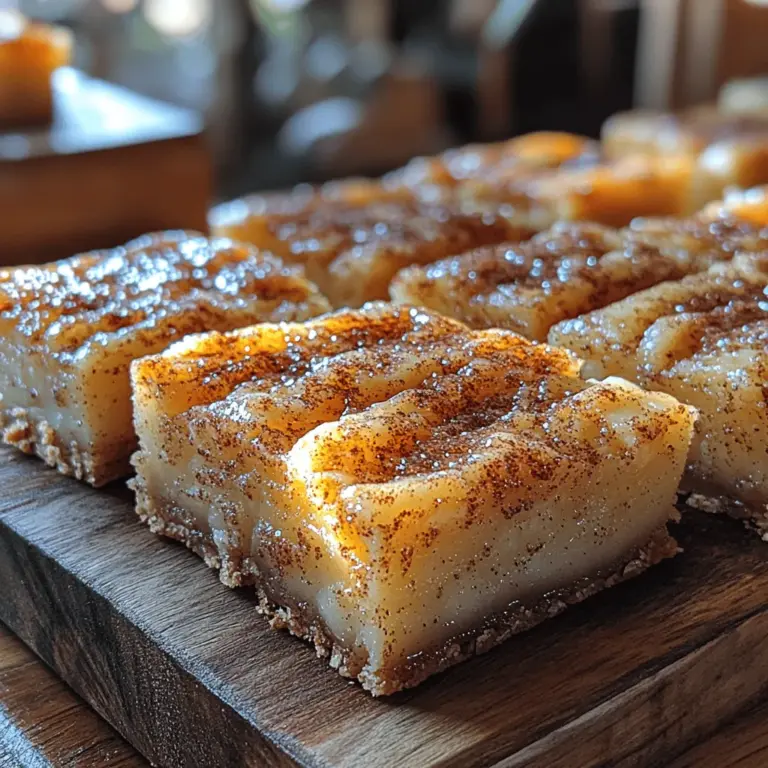Introduction
Soft baked snickerdoodle bars are a delightful twist on the classic snickerdoodle cookie, combining the nostalgic flavors of cinnamon and sugar into a chewy, bar format that is perfect for sharing. This dessert has gained immense popularity over the years, especially among those who appreciate the timeless appeal of snickerdoodles. With their soft, buttery texture and the warm, comforting aroma of cinnamon wafting through the kitchen, these bars are not just a treat; they evoke memories of baking with family during the holidays or enjoying a sweet snack after school.
In the culinary world, the snickerdoodle cookie has a rich history that dates back to the 19th century, with origins often attributed to New England. The unique name is thought to come from the German word “Schnecken,” which means snail, possibly referring to the shape of the cookies. As baking techniques evolved, so did the snickerdoodle, transforming into the beloved treat we know today. The soft baked snickerdoodle bars carry forward this legacy, making them a staple in many households, particularly during festive seasons or family gatherings.
This article will guide you through every step of creating these delicious bars, from understanding the essential ingredients to mastering the preparation techniques. You’ll learn about the nutritional benefits of the ingredients, tips for selecting the best components, and the cooking techniques that bring the flavors together beautifully. Whether you’re a seasoned baker or a beginner looking to impress, this recipe will equip you with the knowledge you need to create the perfect soft baked snickerdoodle bars.
Understanding the Ingredients
Before we dive into the preparation steps, it’s important to understand the key ingredients that make these soft baked snickerdoodle bars so delightful. Each component plays a crucial role in achieving the right texture and flavor.
1. Main Ingredients Overview
– All-Purpose Flour: The foundation of the bars, providing structure and chewiness. Using the right flour is essential for the texture; all-purpose flour gives the bars a soft but sturdy base.
– Granulated Sugar and Brown Sugar: A combination of both sugars helps achieve a perfect balance of sweetness and moisture. Brown sugar adds a hint of caramel flavor and contributes to the chewiness.
– Butter: Unsalted butter is preferred, as it allows you to control the salt content. The butter not only adds richness but also ensures the bars remain soft and tender.
– Eggs: Eggs bind the ingredients together and add moisture. They also help in achieving a fluffy texture that is characteristic of baked goods.
– Baking Powder and Baking Soda: These leavening agents work together to give the bars a slight rise and a soft, cake-like consistency.
– Cinnamon: The star flavor of snickerdoodles, cinnamon adds warmth and sweetness, creating that signature taste associated with these treats.
2. Fresh Ingredients and Their Benefits
While the primary focus is on the dry ingredients, don’t overlook the importance of fresh components. For some variations, you might include vanilla extract or even nutmeg. Fresh vanilla enhances the flavor profile and elevates the aroma of the bars.
3. Herbs and Spices
– Cinnamon: As mentioned, this spice is essential. It’s not just for flavor; cinnamon has health benefits, including anti-inflammatory properties and the ability to regulate blood sugar levels.
4. The Role of Each Ingredient
– Each ingredient contributes to the final texture and flavor of the snickerdoodle bars. The sugars caramelize during baking, creating a slight crust while keeping the interior soft. The butter and eggs work together to provide moisture and richness, while the leavening agents ensure a light, fluffy texture.
5. Tips for Selecting High-Quality Ingredients
– Flour: Opt for unbleached all-purpose flour for better flavor and texture.
– Sugars: Choose organic sugar if possible; it tends to have a more robust flavor.
– Butter: Fresh, high-quality unsalted butter will yield the best results.
– Spices: Always use fresh spices for stronger flavor. Ground cinnamon should be fragrant; if it lacks aroma, it may be past its prime.
Preparation Steps
With an understanding of the ingredients, let’s move on to the preparation steps that set the stage for perfect soft baked snickerdoodle bars.
1. Detailed Preparation of Ingredients
– Begin by measuring out all your dry ingredients: flour, sugars, baking powder, baking soda, and cinnamon. Accurate measurements are crucial in baking, as they affect the overall result.
2. Washing and Chopping Ingredients
– While this recipe doesn’t require fresh vegetables or herbs, if you decide to incorporate nuts or additional spices, ensure they are finely chopped and ready to mix into the batter.
3. Marinating Proteins (if applicable)
– For this particular recipe, marinating is not applicable as we are focusing on a sweet treat. However, it’s worth noting that in other recipes, marinating proteins can enhance flavors.
4. Measuring Spices and Herbs
– For the snickerdoodle bars, you’ll need to measure out the cinnamon carefully, as it’s the dominant flavor. A standard guideline is 2 teaspoons for the bars and an additional 1-2 teaspoons for rolling the bars after baking.
5. Step-by-Step Guidance on Equipment Needed
– Mixing Bowls: Use a large mixing bowl for combining the wet and dry ingredients.
– Electric Mixer: A hand or stand mixer will help achieve a creamy batter, but you can also mix by hand if you don’t have one.
– Baking Pan: A 9×13 inch baking dish is ideal for this recipe, allowing for even baking and easy cutting into bars.
– Measuring Cups and Spoons: Accuracy in measuring is crucial for baking success.
– Rubber Spatula: Perfect for scraping down the sides of the bowl and folding in ingredients.
6. Essential Kitchen Tools for the Recipe
– In addition to the above, having parchment paper on hand will make removing the bars from the pan much easier and prevent sticking. A cooling rack is also beneficial for allowing the bars to cool evenly.
7. Optional Tools for Enhanced Results
– Consider using a kitchen scale for precise measurements, especially if you’re experimenting with different flours or additives. A silicone baking mat can also help with even cooking and easy cleanup.
Cooking Techniques
Understanding the cooking techniques involved in making snickerdoodle bars is essential to achieving the perfect texture and flavor.
1. Explanation of the Cooking Methods Used
– The primary cooking method for snickerdoodle bars is baking. This method allows the sugars to caramelize and the ingredients to meld together, creating a soft and chewy texture.
2. Importance of Timing and Temperature
– Preheat your oven to 350°F (175°C). Proper preheating is crucial, as it ensures even cooking from the start. Bake the bars for approximately 20-25 minutes, checking for doneness by inserting a toothpick in the center—if it comes out clean, the bars are ready.
3. Visual Cues to Know When Each Step is Done
– Watch for the edges of the bars to turn a light golden brown and for the center to appear set but slightly soft. They will continue to cook as they cool, so be careful not to overbake.
4. Tips for Achieving the Best Flavor and Texture
– Avoid overmixing the batter after adding the flour, as this can lead to tough bars. Mix just until combined for the best results. Additionally, allowing the bars to cool in the pan for a few minutes before transferring them to a cooling rack will help them maintain their structure.
By following these steps and techniques, you will be well on your way to creating delectable soft baked snickerdoodle bars that will impress your family and friends. In the next part of this article, we will explore the flavor profile of these bars and provide additional tips to enhance your baking experience.

Balancing Acidity, Sweetness, and Umami
When crafting the perfect soft baked snickerdoodle bars, achieving a balance of flavors is crucial. While this classic dessert is primarily known for its sweetness, it’s essential to consider the role of acidity and umami in enhancing the overall taste profile. The classic snickerdoodle flavor is derived from the combination of sugar, cinnamon, and a touch of cream of tartar, which introduces a mild acidity that helps to cut through the sweetness of the sugar.
To adjust flavors to your personal preference, consider experimenting with the amount of cinnamon or the type of sugar used. For a deeper flavor, you might opt for brown sugar instead of white, as it adds a hint of molasses which complements the cinnamon beautifully. If you prefer a slightly tangy kick, an extra pinch of cream of tartar can do the trick without overwhelming the sweetness. Remember that seasoning is not just a final touch; it should be integrated throughout the cooking process. Taste as you mix and adjust accordingly to create a balanced, flavorful treat that fits your palate.
Serving Suggestions
Presentation is key when serving your soft baked snickerdoodle bars. To create an inviting display, consider cutting the bars into uniform squares and stacking them neatly on a rustic wooden board or a colorful ceramic plate. Dust the top of the bars with a light sprinkle of cinnamon sugar just before serving for that extra touch of elegance.
For a delightful pairing, you can serve these bars with a side of whipped cream or a scoop of vanilla ice cream, which adds richness and a creamy contrast to the soft texture of the bars. Beverages such as freshly brewed coffee, spiced chai tea, or hot apple cider complement the warm spices beautifully. Creative plating techniques like adding a drizzle of caramel sauce or placing a few fresh apple slices beside the bars can enhance visual appeal and make the dish even more enticing.
Nutritional Information
Understanding the nutritional content of your soft baked snickerdoodle bars can help you enjoy them as part of a balanced diet. Each serving typically contains around 200 calories, depending on the size of the bars and the ingredients used.
Macronutrients:
– Carbohydrates: Approximately 28g, primarily from the sugar and flour.
– Protein: Around 2g, sourced from the eggs and flour.
– Fat: Approximately 8g, mainly from the butter used in the recipe.
Micronutrients:
– Calcium: Beneficial for bone health, found in small amounts due to the butter and eggs.
– Iron: Contributes to energy levels, present in the flour.
Health benefits of the main ingredients include cinnamon, which is known for its anti-inflammatory properties and potential to help regulate blood sugar levels. While the bars are not gluten-free, those who are gluten-sensitive can substitute regular flour with a gluten-free blend. These bars are also vegetarian-friendly, making them a suitable treat for various dietary preferences.
Cultural Significance
Snickerdoodles have a rich history that dates back to the early 19th century. Originating in America, the name “snickerdoodle” is believed to have derived from the German word “Schneckennudeln,” which refers to a type of cinnamon roll. This delightful dessert became popular in New England and has since spread across the United States, evolving into various forms and adaptations.
In different cultures, cinnamon plays a significant role in baking, often associated with warmth and comfort. For example, in various Middle Eastern cuisines, cinnamon is used in both sweet and savory dishes, showcasing its versatility. Personal anecdotes often arise around family gatherings during holidays, where snickerdoodle bars or cookies are a staple, evoking cherished memories of warmth and togetherness.
Common Mistakes to Avoid
Making snickerdoodle bars should be a pleasurable experience, yet common pitfalls can detract from the outcome. Here’s a list of mistakes to avoid for perfect bars:
1. Overmixing the Dough: This can lead to tough bars. Mix just until the ingredients are combined.
2. Incorrect Oven Temperature: Ensure your oven is preheated accurately. An oven thermometer can help you verify the temperature.
3. Not Chilling the Dough: If you’re making a thicker bar, chilling the dough can help it hold its shape better while baking.
4. Skipping the Cinnamon Sugar Coating: The signature flavor of snickerdoodles comes from the cinnamon sugar topping, so don’t skip this step.
Signs that something might have gone wrong include a dense texture (indicating overmixing) or a lack of cinnamon flavor (if the sugar topping was omitted). If the bars seem too dry, try reducing the baking time slightly next time or adding a tad more butter.
Variations and Substitutions
To keep your snickerdoodle bars exciting, consider these variations and substitutions:
– Add-ins: Incorporate chocolate chips, nuts, or even dried fruit for a new twist on the classic recipe.
– Flavored Extracts: Experiment with almond or vanilla extract to add depth to the flavor.
– Gluten-Free Options: Substitute all-purpose flour with a gluten-free flour blend for a gluten-free version.
– Seasonal Ingredients: In autumn, add pumpkin spice or even small pumpkin puree to the batter for a festive touch.
Each of these variations allows you to customize the bars while still maintaining the essence of the beloved snickerdoodle flavor.
Conclusion
The soft baked snickerdoodle bars hold a special place in both culinary and cultural contexts, bringing joy and comfort to those who enjoy them. By balancing flavors, focusing on presentation, and understanding the nutritional aspects, you can create a delightful dessert that caters to your preferences and dietary needs. The variations and substitutions provide endless possibilities to explore and enjoy throughout the year.
As you embark on your baking journey, remember that cooking is not just about following a recipe; it’s about experimenting, sharing, and creating memories. Don’t hesitate to add your unique touch to these bars, whether it’s through new flavor combinations or creative presentations. Ultimately, the joy of cooking and sharing meals is what makes the experience truly rewarding. Enjoy your snickerdoodle bars, and happy baking!


